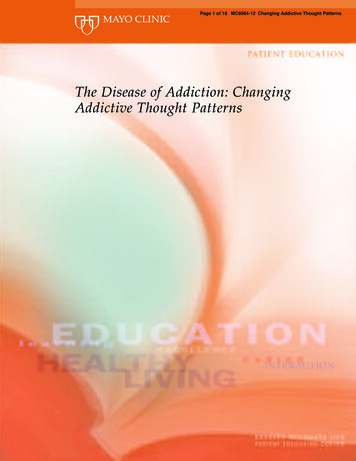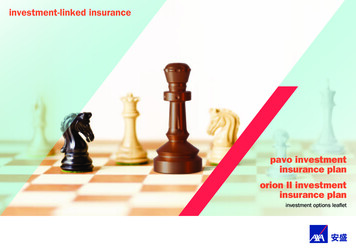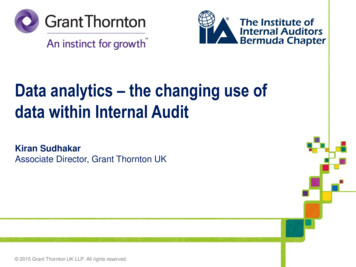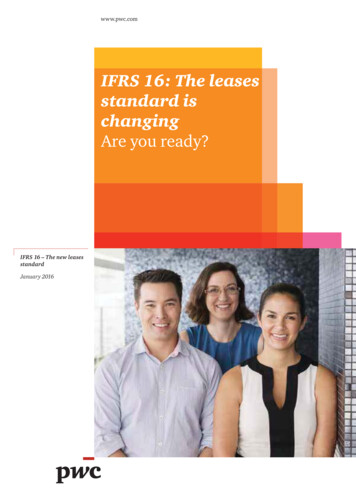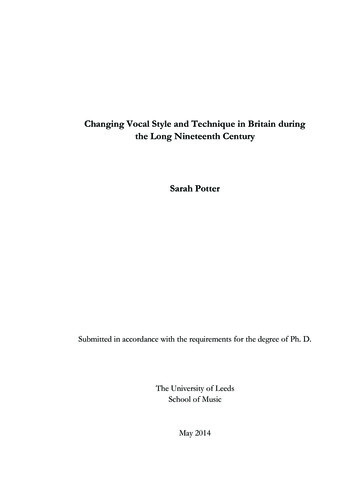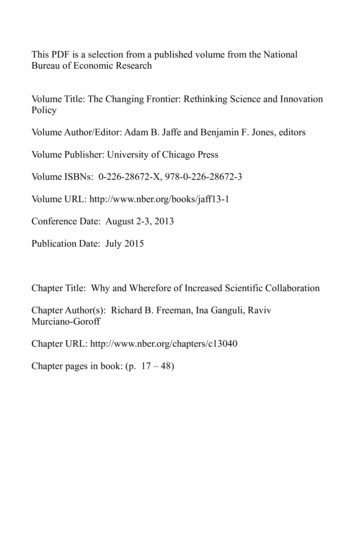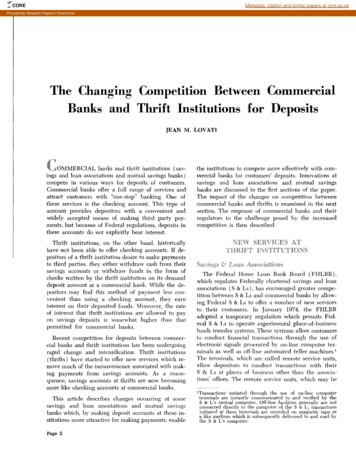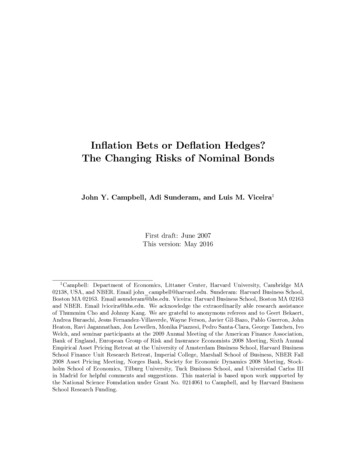
Transcription
The Changing Patterns of Investment in the PRC EconomyCarsten A. Holz*The investment-intensive growth model of the People’s Republic of China (PRC) is oftenviewed as state-driven and ultimately unsustainable. But largely unnoticed, a shift has takenplace. This paper examines the changes in investment patterns since 2003 and the potentialimpact of industrial policies on these patterns. The point of view is macroeconomic, based oneconomy-wide data with various breakdown. Significant shifts in investment patterns acrosssectors and ownership forms have occurred over time, supporting a new growth model with areduced role of the state, and these shifts appear driven more by market factors than bygovernment policies.Journal of Economic Literature classification codes. all People’s Republic of China:E22 Investment, Capital, Intangible Capital, CapacityE6Macroeconomic Policy, Macroeconomic Aspects of Public Finance, and GeneralOutlookL52 Regulation and Industrial Policy — Industrial Policy, Sectoral Planning MethodsO11 Macroeconomic Analyses of Economic DevelopmentO25 Development Planning and Policy — Industrial PolicyO53 Economywide Country Studies — Asia including Middle EastKeywords (all: People’s Republic of China): investment rate, investment policy, nationalinvestment strategy, sector distribution of investment, ownership distribution of investment,causes of investment, economic growthSocial Science DivisionHong Kong University of Science & TechnologyClear Water BayKowloonHong Kongcarstenholz@gmail.com 852.5261.604616 March 2017* This paper draws on work done for Asian Development Bank (ADB) as a staff consultant. The author thanksJurgen Conrad, ZHUANG Jian, and seminar participants at the ADB PRC Resident Mission for many helpfulcomments and suggestions.1
Table of ContentsI.Introduction. 3II.Industrial Policy . 5A.B.C.D.E.F.G.III.2004–2011 . 6Strategic Emerging Industries (2010) . 7Twelfth Five-Year Plan (2011-2015) . 7Supply-side Structural Reform (2015) . 9Thirteenth Five-Year Plan (2016–2020) . 10“Made in China 2025”. 11Sector Focus of Investment . 12Data. 13IV.Univariate Analysis . 16V.A. Sector Distribution of Investment . 171. Primary, Secondary, and Tertiary Sectors . 172. First-digit Sectors . 183. Second-digit Sectors . 194. Fourth-digit Sectors . 21B. Ownership Distribution of Investment . 231. Fixed asset investment . 232. “Urban” investment . 24C. Central vs. Local Investment . 25Multivariate Analysis. 27A. Sector times Ownership . 27B. Investment and Profitability . 30VI.Cumulative Monthly Investment Data, 2016 . 32A. By Sector . 33B. By Ownership . 34VII.Conclusions . 36VIII.References . 38AppendicesAppendix 1: Further Policy Details . 54Appendix 2: Data Availability . 57Appendix 3: Establishing the NBS Definition of “Infrastructure” . 59Appendix 4: Thirty Fastest-Growing Third- or Fourth-digit Sectors, 2010 vs. 2003 . 60Appendix 5: Thirty Fastest-Growing Third- or Fourth-digit Sectors, 2014 vs. 2012 . 61Appendix 6: Thirty Fastest-Growing Third- or Fourth-digit Sectors, 2015 vs. 2014 . 62Appendix 7: Pearson Correlation Coefficients between 2008-2010 Sector Growth Rates andOwnership Characteristics (Urban Investment) . 63Appendix 8: Pearson Correlation Coefficients between 2012–2015 Sector Growth Rates andOwnership Characteristics (Investment, except by Rural Households). 642
I. IntroductionThe high investment rate of the People’s Republic of China (PRC) has attracted muchattention. But the investment rate—measured as the ratio of gross fixed capital formation togross domestic product—has already declined from its peak of 46% in 2010–2013 to 43% in2015, and both the levels and the inverse U-shaped trend of the PRC investment rate overtime are comparable to those of other countries at similar stages of economic development.The changes in patterns of investment, and the factors that drive these changes, are of greatinterest for the PRC’s future economic growth yet have so far escaped attention.In the PRC, investment played a historic role as the cornerstone of the centrally plannedeconomy. In a post-civil war economy, planners allocated investment with a view toestablishing the foundations for a rapidly growing economy. The State Planning Commissionplanned (or authorized) all investment projects. Investment was undertaken by the state andfinanced out of the state budget. Depending on political prerogative, planners preferablychanneled investment into heavy industry, light industry, or the Third Front Construction.1In the reform period, investment planning morphed into an investment approvalprocedure. By liberalizing prices, the “investment hunger” of the socialist system (Kornai,1979) that was previously kept in check through fixed prices and physical planning—and ledto shortages—now triggered price increases. Investment approval procedures then became anactive tool of macroeconomic policy. For example, central investment policies played acrucial role in the 1988/89 contractionary macroeconomic policies when planners, in order toreign in double-digit inflation, ordered investment projects to be stopped and denied approvalfor new projects.2 The approval requirement was dismantled only gradually, with a majorrelaxation of approval procedures in 2004, though continuing for some types of projects.In the face of the current annual economic growth targets, investment also matters as acomponent of aggregate demand. Consumption’s contribution to annual real GDP growth isrelatively stable, with on average 5.5 percentage points in the years from 1979 through 2015(NBS database). The contribution of net exports fluctuates tremendously, with a long-runaverage of 0.2 percentage points per year. The average annual contribution of gross capitalformation (gross fixed capital formation plus the typically very small item inventory1On the Third Front Construction, see, for example, Naughton (1988). It denotes the creation of an industrialbase in the PRC’s heartland between 1964 and 1971 as a defensive measure against a foreign aggressor (thatwas expected to breach the first front, the PRC’s shoreline or land border, and then to be stopped in the secondfront, the area between the shoreline / land border and the new industrial heartland).2For details on the 1988/89 contractionary macroeconomic policy period see Holz (1999).3
investment) is 4.1 percentage points, with some variation over time. Of the aggregateexpenditure components, gross capital formation responds quickest and most reliably tocentral government policies and since the early 2000s has been as important as consumptionfor generating annual economic growth.Gross capital formation played a particularly important role in the aftermath of the 2008U.S. financial crisis, in 2009 and 2010. But by 2016, based on the official first release of data(CEIC database), consumption contributed 4.3 percentage points to GDP growth, grosscapital formation 2.8% and net exports –0.5%. I.e., gross capital formation’s contribution toGDP growth, relative to consumption’s contribution, has now fallen below its long-run level.Given that annual investment fluctuates more than consumption, stable annual economicgrowth is conditioned on a continuously growing stream of investment. The PRCgovernment’s growth prerogative then translates into maintaining a high growth rate ofinvestment. The central government influences investment directly through public investmentin infrastructure, and through government industrial policies favoring particular types ofprojects. The government also influences investment indirectly through regulatorymechanisms as well as interest rate and tax policies.But the government’s push for investment at times of otherwise low GDP growth rates—such as in the aftermath of the 2008 U.S. financial crisis, or to stop the growth slowdown in2015/16—has been criticized as leading to “overinvestment.” Overinvestment is taken tocause inefficient resource allocation, excess capacity, high levels of debt, and poor assetquality. For example, BAI Chong-en et al. (2016) suspect that local governments’ access tofinancial resources translates into investment that potentially worsens the overall efficiencyof capital allocation. Others have expressed concern about an increasing role of the state ininvestment, with a supposedly receding share of the private sector in 2016.This leads to a conundrum: on the one hand, the central government would like to see astable and relatively high investment rate for the sake of economic growth. On the otherhand, it would prefer not to have to deal with the negative consequences of overinvestment ormis-investment. One solution is to encourage private investment, leaving any consequencesof overinvestment or mis-investment for the private sector to sort out.The shift in the government’s management of investment originally occurred in the mid2000s. In 2004, the investment approval procedures were relaxed, loosening the grip ofplanners on the volume of investment. But the government not only wants stable andreasonably high investment growth, it also would like investment to flow in sectors of itspreference. Since the early 2000s, the central government has issued a plethora of industrial4
policy measures in an attempt to direct investment (and productive activities). Investment’srole as macroeconomic policy tool, thus, has bee reduced, but investment continues to serve arole in strategic economic planning.This paper examines the changes in investment patterns since 2003, and explores theimpact of the changes in decision-making and in industrial policies on investment. The pointof view is macroeconomic, based on economy-wide data with various breakdowns. In thepresence of a multitude of policies, each listing a great number of desirables, a singularhypothesis to be tested quantitatively cannot be the objective of this paper. Rather, a firstobjective of this paper is to show the changes in investment patterns that have happened andare continuing to be underway. The second objective is to relate the observed changes ininvestment patterns to industrial policies and to draw conclusions on the impact of the centralgovernment, through its policies, on investment outcomes in the PRC.This big picture is still missing from the literature. Business-oriented new items andarticles may report the latest monthly changes in real estate investment. The academicliterature tends to focus on foreign investment in PRC (such as its effects on exports), onfinancing constraints in the PRC, and on investment efficiency (typically as part ofproduction function estimations). Slightly closer to the topic here, one recent article finds thatcertain categories of listed firms restrict investment in the face of economic policyuncertainty (WANG et al., 2014), while another finds no impact of real estate collateral valueon firm investment (WU et al., 2015).The next section extracts specific industrial policies from the various industrial policymeasures issued since the mid-2000s and from the latest Five-Year Plans. This is fol
Explicit industrial policy as an instrument of economic reform first emerged in the PRC’s Seventh Five-Year Plan (1986–1990), but early policies appeared to have little effect.3 This changed in the 2000s. 3 For an overview of the development of industrial policy in the
